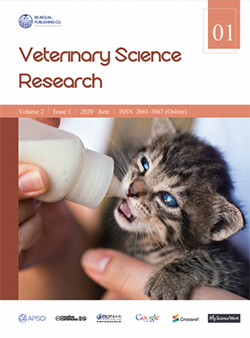Meta-Analysis on Efficacy of Vaccination against Staphylococcus aureus and Escherichia coli
DOI:
https://doi.org/10.30564/vsr.v2i1.1929Abstract
Mastitis is a common disease responsible for the biggest economic loss in the dairy industry. Antibiotic therapy does not provide long-term protection. And residue is a major concern in food safety. Vaccination is an alternative control method with great potential for bovine mastitis. Our study focus on evaluating vaccine efficacy regarding reducing the incidence of clinical and subclinical mastitis. Meta-analysis was used to pool data extracted from previous studies. 26 records from 13 studies were examined. A fixed effect model was constructed assigning incidence as the measurement of the outcome. Risk ratio (RR) was the parameter that measured the incidence differences between treated group and control group. Studies and records were categorised based on vaccine antigens. In vaccine against Staphylococcus aureus, RR was 0.76; 95% CI (0.65,0.89), while in vaccine against Escherichia coli RR was 0.96; 95% CI (0.86,1.08).
Keywords:
Bovine mastitis, Vaccination, Meta-analysisReferences
[1] Kauf AC, Vinyard BT, Bannerman DD. Effect of intramammary infusion of bacterial lipopolysaccharide on experimentally induced Staphylococcus aureus intramammary infection. Res Vet Sci. 2007, 82(1):39–46.
[2] De Vliegher S, Fox LK, Piepers S. et al. Invited review: Mastitis in dairy heifers: nature of the disease, potential impact, prevention, and control. J Dairy Sci. 2012, 95(3):1025–1040.
[3] Gomes F, Henriques M. Control of Bovine Mastitis: Old and Recent Therapeutic Approaches. Curr Microbiol. 2016, 72(4):377–382.
[4] Kromker V, Leimbach S. Mastitis treatment-reduction in antibiotic usage in dairy cows. Reprod Domest Anim. 2017, 52(Suppl 3):21–29.
[5] Yoshida K, Ichiman Y, Narikawa S. Staphylococcal capsular vaccine for preventing mastitis in two herds in Georgia. J Dairy Sci. 1984, 67(3):620–627.
[6] Calzolari A, Giraudo JA, Rampone H, et al. Field trials of a vaccine against bovine mastitis. 2. Evaluation in two commercial dairy herds. J Dairy Sci. 1997, 80(5):854–858
[7] Morimoto K, Shimizu M, Kurose T. Efficacy of enterotoxigenic Escherichia coli vaccine for bovine clinical mastitis. J Dairy Res. 2011, 78(2):149–153.
[8] Nordhaug ML, Nesse LL, Norcross NL, et al. A field trial with an experimental vaccine against Staphylococcus aureus mastitis in cattle. 1. Clinical parameters. J Dairy Sci. 1994, 77(5):1267–1275.
[9] Watson DL, McColl ML, Davies HI. Field trial of a staphylococcal mastitis vaccine in dairy herds: clinical, subclinical and microbiological assessments. Aust Vet J. 1996, 74(6):447–450.
[10] Wilson DJ, Grohn YT, Bennett GJ, et al. Comparison of J5 vaccinates and controls for incidence, etiologic agent, clinical severity, and survival in the herd following naturally occurring cases of clinical mastitis. J Dairy Sci. 2007, 90(9):4282–4288.
[11] Pereira UP, Oliveira DG, Mesquita LR, et al. Efficacy of Staphylococcus aureus vaccines for bovine mastitis: a systematic review. Vet Microbiol. 2011, 148(2–4):117–124.
[12] Leitner G, Yadlin N, Lubashevsy E, et al. Development of a Staphylococcus aureus vaccine against mastitis in dairy cows. II. Field trial. Vet Immunol Immunopathol. 2003, 93(3-4):153–158.
[13] Slim K, Nini E, Forestier D, et al. Methodological index for non-randomized studies (minors): development and validation of a new instrument. Anz J Surg. 2003, 73(9):712–716.
[14] McClure AM, Christopher EE, Wolff WA, et al. Effect of Re-17 mutant Salmonella typhimurium bacterin toxoid on clinical coliform mastitis. J Dairy Sci. 1994, 77(8):2272–2280.
[15] Bradley AJ, Breen JE, Payne B, et al. An investigation of the efficacy of a polyvalent mastitis vaccine using different vaccination regimens under field conditions in the United Kingdom. J Dairy Sci. 2015, 98(3):1706–1720.
[16] Gonzalez RN, Cullor JS, Jasper DE, et al. Prevention of clinical coliform mastitis in dairy cows by a mutant Escherichia coli vaccine. Can J Vet Res. 1989, 53(3):301–305.
[17] Hoedemaker M, Korff B, Edler B, et al. Dynamics of Staphylococcus aureus infections during vaccination with an autogenous bacterin in dairy cattle. J Vet Med B Infect Dis Vet Public Health. 2001, 48(5):373–383.
[18] Ozsvari L, Muntyan J, Filipsz I. The production effects and economic evaluation of vaccination against mastitis caused by staphylococci and E.coli in a Hungarian large-scale Holstein-Friesian dairy herd. Magy Allatorvosok. 2016, 138(4):195–206.
Downloads
Issue
Article Type
License
Copyright and Licensing
The authors shall retain the copyright of their work but allow the Publisher to publish, copy, distribute, and convey the work.
Veterinary Science Research publishes accepted manuscripts under Creative Commons Attribution-NonCommercial 4.0 International License (CC BY-NC 4.0). Authors who submit their papers for publication by Veterinary Science Research agree to have the CC BY-NC 4.0 license applied to their work, and that anyone is allowed to reuse the article or part of it free of charge for non-commercial use. As long as you follow the license terms and original source is properly cited, anyone may copy, redistribute the material in any medium or format, remix, transform, and build upon the material.
License Policy for Reuse of Third-Party Materials
If a manuscript submitted to the journal contains the materials which are held in copyright by a third-party, authors are responsible for obtaining permissions from the copyright holder to reuse or republish any previously published figures, illustrations, charts, tables, photographs, and text excerpts, etc. When submitting a manuscript, official written proof of permission must be provided and clearly stated in the cover letter.
The editorial office of the journal has the right to reject/retract articles that reuse third-party materials without permission.
Journal Policies on Data Sharing
We encourage authors to share articles published in our journal to other data platforms, but only if it is noted that it has been published in this journal.




 Ziyang Fu
Ziyang Fu

